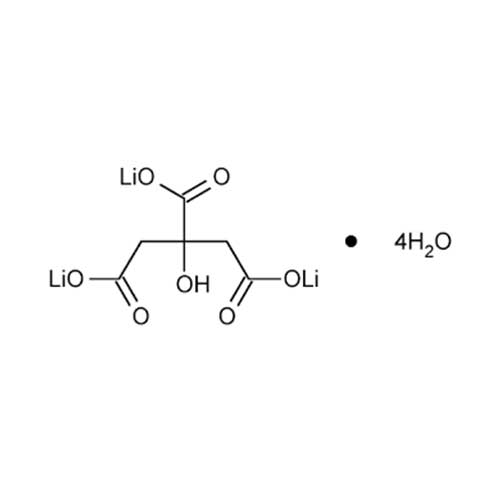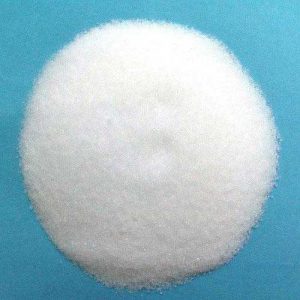- Have any questions?
- 91-22-23726950
- 91-22-23774610

Lactic Acid
May 7, 2019
Magnesium Chloride Hexahydrate & Anhydrous
May 7, 2019Lithium Citrate
Muby Chemicals established in the year 1976, is pioneer in Manufacturing Chemicals for Oil and Gas Exploration, Hydraulic Fracturing (Fracking) and coiled tube Chemicals.Our advanced chemistry leading to an innovative and high-performance product range is coupled with effective on and off site management services.
We are manufacturer of Specialty chemicals, Pharmaceutical Excipients, Fragrance & Flavorchemicals in India, which are of IP, BP, USP, Ph. Eur., FCC or Food Grade, ACS, AR or Analytical Reagent Grade, LR or Laboratory Reagent Grade, Pure and Technical Grades of various chemicals.
Lithium Citrate BP
Ph Eur
C6H5Li3O7,4H2O — 282.0 — 6080-58-6
DEFINITION
Trilithium 2-hydroxypropane-1,2,3-tricarboxylate tetrahydrate.
Content: 98.0 per cent to 102.0 per cent (anhydrous substance).
CHARACTERS
Appearance: White or almost white, fine crystalline powder.
Solubility: Freely soluble in water, slightly soluble in ethanol (96 per cent).
IDENTIFICATION
A. When moistened with hydrochloric acid, it gives a red colour to a non-luminous flame.
B. Dilute 3 ml of solution S (see Tests) to 10 ml with water. Add 3 ml of potassium ferriperiodate solution. A white or yellowish-white precipitate is formed.
C. To 1 ml of solution S add 4 ml of water. The solution gives the reaction of citrates.
TESTS
Solution S: Dissolve 10.0 g in carbon dioxide-free water prepared from distilled water and dilute to 100 ml with the same solvent.
Appearance of solution: Solution S is clear and colourless.
Acidity or alkalinity: To 10 ml of solution S add 0.1 ml of phenolphthalein solution. Not more than 0.2 ml of 0.1 M hydrochloric acid or 0.1 M sodium hydroxide is required to change the colour of the indicator.
Readily carbonisable substances: To 0.20 g of the powdered substance to be examined add 10 ml of sulphuric acid and heat in a water-bath at 90 ± 1C for 60 min. Cool rapidly. The solution is not more intensely coloured than reference.
Chlorides: Maximum 100 ppm.
Oxalates: Maximum 300 ppm, calculated as anhydrous oxalate ion.
Sulphates: Maximum 500 ppm.
Heavy metals: Maximum 10 ppm.
Water: 24.0 per cent to 27.0 per cent, determined on 0.100 g.
ASSAY: Dissolve 80.0 mg in 50 ml of anhydrous acetic acid, heating to about 50C. Allow to cool. Titrate with 0.1 M perchloric acid, using 0.25 ml of naphtholbenzein solution as indicator, until the colour changes from yellow to green.
1 ml of 0.1 M perchloric acid is equivalent to 7.00 mg of C6H5Li3O7.
STORAGE: In an airtight container .
Lithium Citrate USP
C6H5Li3O7.4H2O 281.98
1,2,3-Propanetricarboxylic acid, 2-hydroxy-trilithium salt tetrahydrate.
Trilithium citrate tetrahydrate [6080-58-6].
Anhydrous 209.93 [919-16-4].
Lithium Citrate contains not less than 98.0 percent and not more than 102.0 percent of C6H5Li3O7, calculated on the anhydrous basis.
Identification:
A: When moistened with hydrochloric acid, it imparts an intense crimson color to a nonluminous flame.
B: It responds to the test for Citrate.
pH: between 7.0 and 10.0, in a solution (1 in 20).
Water: Dry it at 150 for 3 hours: it loses between 24.0% and 28.0% of its weight.
Carbonate: Add about 0.5 g to 5 mL of 6 N acetic acid: not more than a slight effervescence is produced.
Heavy metals: the limit is 0.001%.
For Original Monographs of IP Indian Pharmacopoeia BP British Pharmacopoeia USP US Pharmacopoeia FCC Food Grade product, please check with the respective web-pages or books.




